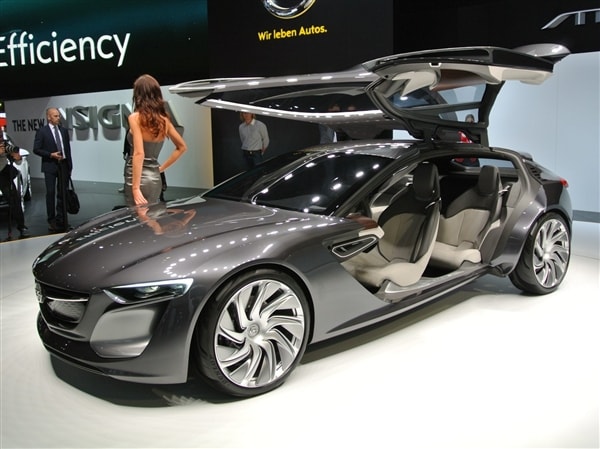Opel Monza Concept opens new design doors
Opel Monza Concept opens new design doors

1 / 16
Resurrecting a classic model name from its own marque history, the Opel Monza Concept rolled into Frankfurt boasting a host of new design elements from its avant-garde styling to its enhanced use of on-board electronics to its unique variation on GM's E-REV (Extended-Range Electric Vehicle) propulsion technology pioneered on the Chevrolet Volt and its European opposite number, the Opel Ampera. According to Opel CEO, Dr. Karl-Thomas Neumann, this elegantly extreme vision "represents the Opel car of tomorrow." Given the level of current and projected future product-sharing alignment between the General's upline European division and Buick here in the U.S., it also seems possible that at least some of the groundbreaking innovations introduced in the Monza Concept also might find their way to America.
Combining the visual flair of a coupe with the practicality of a sleek wagon, the Monza Concept expands on design themes introduced in the latest generation Opel Insignia - which made its Atlantic crossing to become our current Buick Regal. However with far bolder contours, a sweeping roofline and more sculpted surfaces intended to project of feeling of lightness while recalling the pattern of waves rolling onto shore, the Monza is a breed apart. As a final flourish, it features pair of large gullwing doors that, unencumbered by conventional B-pillars, swing up and away to provide easy access to the Monza's spacious 4-passenger inner sanctum.
While its basic cabin trappings of fine leather, wood and metal are smartly turned out in their own right, it's the dash treatment that really sets the new Monza Concept apart. Mindful that enhanced connectively and user-friendliness will be critical to satisfying buyer needs in the coming years, Opel's design group relied on extensive consumer research to develop a configuration that would serve as a benchmark for future Human Machine Interfaces (HMI). The result is a highly sculpted, full-digital panel that runs from door to door and consists of 18 LED projectors that can function individually or in any grouping to provide any and all information required but no more than is necessary or requested. Presented in vivid 3D, the various functional data -- or even decorative backgrounds -- can be dialed up using voice control or the multifunction steering wheel.
The Monza's advanced HMI system also provides for three different levels of smartphone connectivity dubbed ME, US and ALL. The first virtually decouples the driver's smartphone from the on-board infotainment system to maintain full focus on the vehicle's command and control functions. US allows passengers to use their personal devices to log on and link up with others while ALL permits everyone on board including the driver to share everything from music to the route being travelled with the outside world. The Opel system also is designed to accommodate the full range of forthcoming Car-to-Car and Car-to-X technologies that will allow automatic real-time communications between vehicles and/or various data providers to help reduce the potential for accidents or warn of various traffic conditions.
The Monza also features modular platform architecture that allows for the fitment of a wide range of conventional and advanced powertrains. In this case, the existing E-REV 1.4-liter gasoline-burning 4-cylinder range-extender that creates electricity on the fly to directly energize the traction motor is replaced by a new 1.0-liter/3-cylinder engine that runs on compressed natural gas. Opel offered no specifics on performance or MPGe numbers, but it did confirm that the smaller engine and cleaner-burning fuel results in a significant reduction in CO2 emissions.
While it's still too soon to tell where the fantasy ends and the future really begins, there's no denying the Opel Monza Concept does offer some very interesting alternative takes on conventional thinking.
